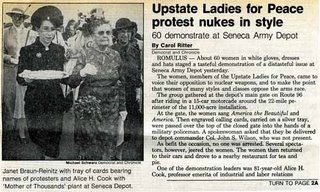Date: October 4, 1983
PeHP source: Bryna Fireside

Caption: Janet Braun-Reinitz with a tray of cards bearing names of protesters and Alice H. Cook with 'Mother of Thousands' plant at Seneca Depot.
Photo by Michael Schwartz
Upstate Ladies for Peace protest nukes in style
60 demonstrate at Seneca Army Depot
by Carol Ritter
ROMULUS - About 60 women in white gloves, dresses and hats staged a tasteful demonstration of a distasteful issue at Seneca Army Depot yesterday. The women, members of the Upstate Ladies for Peace, came to voice their opposition to nuclear weapons, and to make the point that women of many styles and classes oppose the arms race.
The group gathered at the depot’s main gate on Route 96 after riding in a 15-car motorcade around the 22-mile perimeter of the 11,000-acre installation. At the gate, the women sang American the Beautiful and America. Then engraved calling cards, carried on a silver tray, were passed over the top of the closed gate into the ands of a military policeman. A spokeswoman asked that they be delivered to depot commander Col. John S. Wilson, who was not present.
As befit the occasion, no one was arrested. Several spectators, however, jeered the women. The women then returned to their cars and drove to a nearby restaurant for tea and pie. One of the demonstration leaders was 81-year-old Alice H. Cook, professor emerita of industrial and labor relations at Cornell University. Cook climbed onto a wooden box at the gate and read her statement.
“We stand here this afternoon dressed as we are as a reminder that working for the abolition of nuclear weapons can take many forms, and needs to be expressed in many styles until our world leaders understand that we value and cherish life on our planet,” she said. Cook then held up a potted plant, which was later passed over the gate, and said, “In the name of life, we present this plant, a strawberry begonia, sometimes called ‘The Mother of Thousands,’ for each new shoot can grow into a full plant of its own. We hope that each time it is watered, it will be an act of continuing this life.”
Two of the group’s organizers, Janet Braun-Reinitz and Bryna Fireside, both of Ithaca, said they hoped that by wearing conventional, dressy clothing that they would persuade people to take heed of their message. They said that they were concerned that many area residents ignored the other anti-nuclear protests at the depot because of the casual and sometimes-unorthodox dress of those protesters.
The depot was the scene of protests by thousands of women this summer including several by the Women’s Encampment for a Future of Peace and Justice. Women from throughout the United States and several foreign countries stayed at the encampment, a 52-acre farm adjacent to the depot, from June through September. The depot is believed to be a storage facility for nuclear-armed cruise and Pershing missles [sic] that are scheduled to be deployed in Europe this month. The military will neither confirm or deny the existence of nuclear weapons at any site. The appropriate dress yesterday was also symbolic for some.
Celia Bolyard, a real estate saleswoman from Ithaca, wore a small a black velour hat she said belonged to her late mother, Sara Wicks, who died last spring at 93.
“Mother was a liberated lady. She would have been very supportive of what we are going [sic] here today. I believe she would be proud to know that I am wearing her hat,” Bolyard said.
Men wearing three-piece suits and ties drove the cars that carried the white-gloved women and a few other men from the camp to the depot gate on Route 96. When the cars arrived at the main gate, they were met by about 30 people. Two Waterloo women, Ruth Stanover and her daughter Debbie, wore camouflage fatigues and held small American flags.
Another woman at the gate wore a women’s naval uniform and a sign, “Tasteful Ex-Servicewomen for Peace.” She identified herself as Mary Hilton of Scipio Center and said she served in the Navy in 1974 in Orlando, Fla. “I’m here because I feel deployment of the (U.S. nuclear) missiles is asking ofr trouble. It’s like saying, ‘I dare you to do something about it,’” she said.
No comments:
Post a Comment